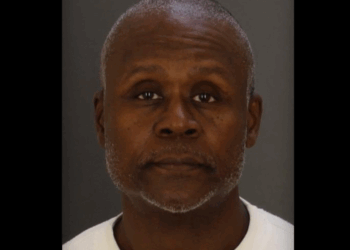Editor’s Note: This article contains images of explicit Smithsonian exhibits.
Corporate media forces are whining about President Donald Trump’s observation that the Smithsonian Institution is far too focused on slavery, and not focused enough on America’s greatest triumphs.
According to CNN, Trump “escalates attacks against Smithsonian museums, says there’s too much focus on ‘how bad slavery was.’”
Last week, the Trump administration initiated a review of the Smithsonian’s materials, exhibits, curation processes, and narratives to begin to restore honesty to the story of America, as told by a network of museums — a network that, if run properly, is one of America’s greatest treasures and part of Americans’ cultural inheritance.
In its own words, the Smithsonian is the “keeper of memory for the nation.”
Trump reinitiated his criticism of how badly the academic left has degraded the Smithsonian on Tuesday, noting, “The Smithsonian is OUT OF CONTROL, where everything discussed is how horrible our Country is, how bad Slavery was, and how unaccomplished the downtrodden have been — Nothing about Success, nothing about Brightness, nothing about the Future. We are not going to allow this to happen, and I have instructed my attorneys to go through the Museums, and start the exact same process that has been done with Colleges and Universities where tremendous progress has been made.”
He is absolutely correct.
As The Federalist reported, one need look no further than the American History Museum, where even an exhibit about Benjamin Franklin’s scientific research and achievements could not get further than two sentences without mentioning slavery — even going as far as making random assertions about his slaves’ involvement in experiments, while simultaneously admitting it had no evidence for those assertions.
Slavery is part of American history, but the Smithsonian has gone to great lengths to inject mentions of it into nearly every single exhibit, and if the history is more recent than the abolition of slavery, it is entirely focused on racism, social justice, oppression, and the rest of the self-hatred pushed by the academic left.
The purpose is to degrade America, its shared history, and its cultural expression.
Directly undermining the institution’s original purpose of being “an establishment for the increase and diffusion of knowledge among men,” propagandists have taken over the museum’s curation and exhibits, ensuring that America is portrayed as an oppressive, evil, racist, divisive, and enslaving force throughout history, and that there is no amount of social justice-embracing that can be done for it to recover.
But the American History Museum is not the only culprit.
National Museum of African Art
Visitors to the National Museum of African Art will be accosted by the 55-minute movie Five Murmurations, a production aimed at advancing the bogus “national racial reckoning” narrative from 2020.
The movie is by a Ghanaian artist John Akomfrah, who is based out of London, England, and the film is meant to showcase his “response to the global pandemic, murder of George Floyd, and worldwide protests in support of Black Lives Matter.”
Leaving aside the fact that George Floyd was decidedly not murdered, but died as a result of the drugs he was on — or the reality that “Black Lives Matter” scammed millions out of money, caused billions in damage, and was one of the primary forces behind pushing fake narratives about the oppression of black people in America and in the Western world writ large — the exhibit is meant to instill a negative feeling about America, uncritical of reality, with the intention of indoctrinating its viewers.
It is shown in a large, dark theater, and the film itself is extremely dim with intense audio. It has police encounters, ominous music, and short clips interspersed with photographs. It shows still images of George Floyd followed by text like “dying violently” and “black lives.” The entire film is dark and somber.
A major takeaway from the film is that 2020 was defined by the systematic oppression of blacks, while white supremacists (including law enforcement) roamed the streets murdering black people in cold blood.
It also seems to place on equal footing the deaths of George Floyd, communist revolutionary Che Guevara, and Jesus Christ.
The New York Times, which did a profile on Akomfrah and the movie, described the scene: “In one kaleidoscopic sequence, for instance, stills of the police officer Derek Chauvin kneeling on Floyd’s neck are juxtaposed with archival photographs of the executed revolutionary Che Guevara and the Renaissance painter Andrea Mantegna’s ‘Lamentation over the Dead Christ.’”
Akomfrah himself described George Floyd’s “aura in death” as “Christlike,” adding, “Part of it is just the very public nature of the death: The banality, the stupidity of it — the sheer awfulness of it — seemed to transform him into something else.”
Continuing on with messaging about colonialism, slavery, and the apparent evildoing of the United States and United Kingdom, the film is meant to advance the narrative that present-day America is exactly the same as America when slavery existed, and that white supremacy is widespread.
National Museum of Natural History
The Natural History Museum has an exhibit looking to advance a similar narrative.
In a part of the “Cellphone: Unseen Connections” exhibit called “Images of Violence: The Cellphone As Witness,” a black female and a Muslim female teach a male that cellphone footage of alleged violence against non-white people is basically the only way to advance justice.
“Without videos like these, we wouldn’t know what happened to countless black citizens,” the black female states. The exhibit does not address the fact that the footage is often one-sided and abused by activists and the media to form a narrative that is not true in order to advance a social justice cause — as happened with George Floyd.
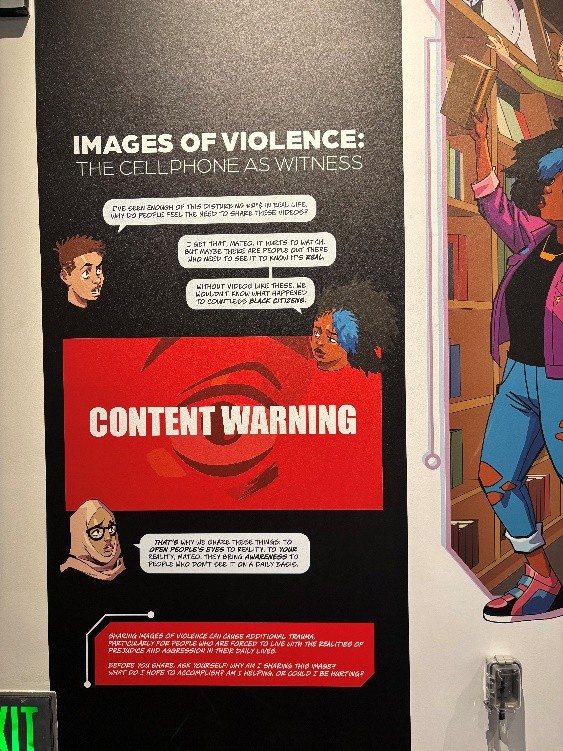
Image CreditCourtesy of Tourists and Visitors of the Smithsonian museums
“Sharing images of violence can cause additional trauma,” a caption at the bottom of the section states. “Particularly for people who are forced to live in the realities of prejudice and aggression in their daily lives.”
In “Social Justice: The Cellphone As Catalyst,” the exhibit describes in a positive light how cellphones were used to advance the “Black Lives Matter” scam.
“I can’t imagine the Black Lives Matter movement happening without cellphones. So much of it was driven by footage of injustice that people captured with their camera phones,” the black female states. “Without brave bystanders using their phones to witness wrongdoing, the movement may not have gained ground.”
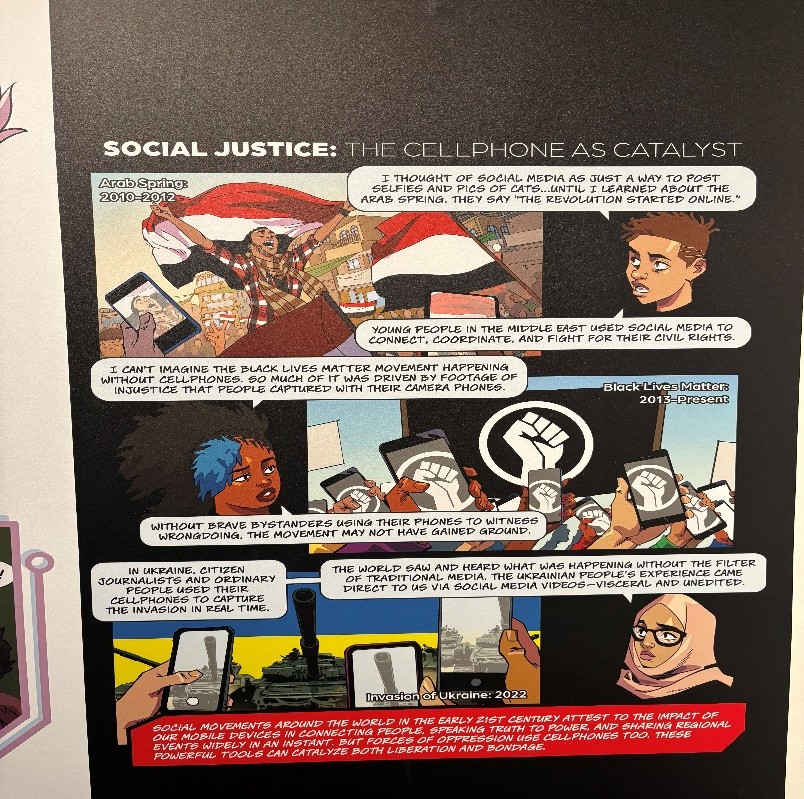
Image CreditCourtesy of Tourists and Visitors of the Smithsonian museums
A caption notes that “forces of oppression use cellphones too.” Another part of the exhibit says phones can also be used to share “music for social justice.”
National Portrait Gallery and American Art Museum
The National Portrait Gallery and the American Art Museum are two of the most potent institutions for portraying America and Americans by preserving and displaying American identity and culture. Perhaps more than all other Smithsonian museums, these two have the ability to shape the public impression of who Americans are and what it means to be an American.
They, too, have been sullied by an overemphasis on oppression, a curatorial process meant to mislead, and a narrative rife with omissions that make America look evil.
Curation appears to be angled toward obscurity for the purpose of indoctrination and selective revisionism all in order to advance a narrative of America that it is a society built on injustice, exclusion, and failure.
Instead of advancing narratives that highlight the contributions of important statesmen, scientists, and inventors, and those who had immense influence on American culture, the museums advance a story about environmental doom, racial grievance, and criticism of American ideals, claiming that they were always flawed.
American industry and advancement are maligned as the source of environmental destruction. Oppression is portrayed as a constant, and there is very little mention of the rights protected by the Constitution. Pieces of art seek to deconstruct the founding understanding of liberty and the noble goals sought by the American founding.
The museums leave the impression that the nation is defined by division and contradictions alone and not by an evolution and progression through struggle and perseverance, denigrating American culture or viewing it skeptically.
For example, in a description about the Statue of Liberty, the Smithsonian says, “Liberty stands on a broken chain to symbolize victory over tyranny, a narrative that omits the millions of enslaved Africans forcibly brought to this land in the decades before and after the Revolution.”
After noting the inscription “Give me your tired, your poor, Your huddled masses yearning to breathe free. … I lift my lamp beside the golden door!” the Smithsonian decided it would be important to make determinative statements about American immigration policy, writing, “Yet racist anti-immigration laws barred many from entering the country.”
It also sought to malign Francis Scott Key, who composed America’s national anthem, “The Star-Spangled Banner,” stating, “During Key’s lifetime, abolitionists noted the irony of a song about ‘the land of the free’ written by a staunch advocate of slavery with narrow views of freedom.”
National Museum of Asian Art
The Asian Art Museum is home to pieces going back thousands of years. Its collections boast Mesopotamian cylinder seals, Qing Dynasty scrolls, Mughal paintings, and much more.
Recent distortions of its mission, however, have seen it attempt to superimpose Western gender theory nonsense on an otherwise rich display of Asian philosophy, spiritualism, and art. As a result, the museum now has a battle between traditional art and far-left activism meant to convince visitors that things like drag shows and the like are really aspects of rich Asian culture.
Some exhibits are offensively blatant propaganda, taking significant liberties with the meaning of “Asian art” and degrading cultural narratives in order to advance messaging on identity, gender, power, and sexuality.
“Body Transformed: Contemporary South Asian Photographs and Prints” does exactly this by focusing on themes about gender ambiguity and queer identity and expressly “confront[ing] notions of gender and cultural identity through photography” to “explore representations of power, place, and sexuality in today’s world.”
The exhibit portrays a man named Chapal Bhaduri as a victimized homosexual. Bhaduri played female roles in a traditional style of Bengali folk theater called jatra. However, the inclusion of Bhaduri is not really a way to talk about jatra, but rather to shoehorn in commentary about Western victimhood and subversion narratives.
In a section on Bhaduri called “performing the goddess,” Smithsonian writes, “For almost every night for nearly half a century, Chapal Bhaduri (b. 1938) transformed himself. With each application of makeup and change in dress, Bhaduri became a female character in a performance of jatra.”
“Being a gay actor playing a female character in folk theater further marginalized him, but he eventually found work performing as Sitala, an ancient goddess worshipped primarily for protection from disease,” it added, showcasing his process of putting on makeup and “transforming” into a female.
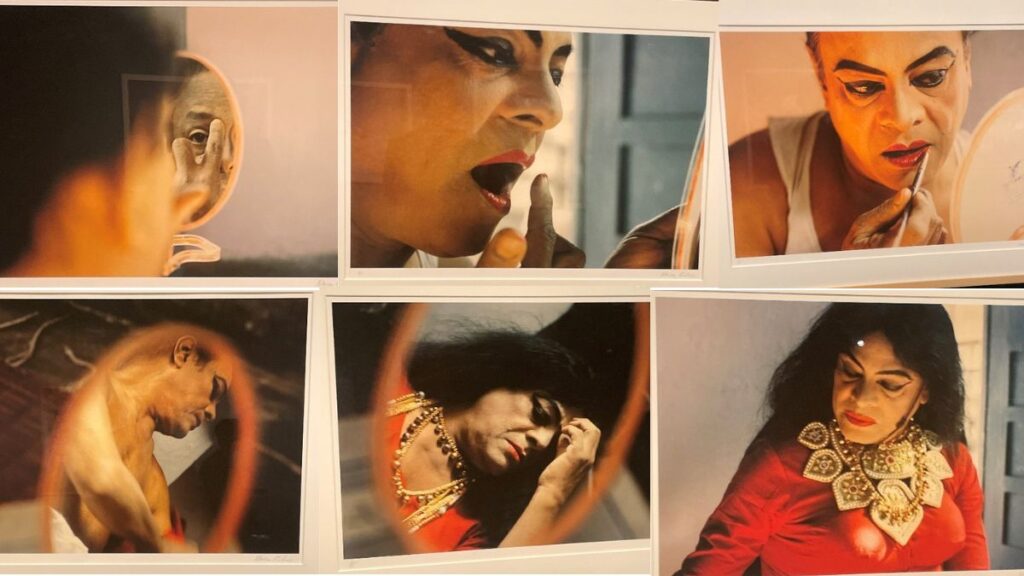
Image CreditCourtesy of Tourists and Visitors of the Smithsonian museums
“To enter the skin of a person is to become that person … It’s a very liberating act,” the Smithsonian states, quoting someone named “Pushpamala N.”
Chitra Ganesh is another modern artist celebrated by the museum. Her art is focused on transgressing religious iconography and “dismantl[ing] conventional notions of sexuality, gender, and power.”
For example, her grotesque works in “Shape-Shifters … suggest the ever-evolving state of the woman’s body between disappearance and emergence, dissolution and creation,” according to the Smithsonian.
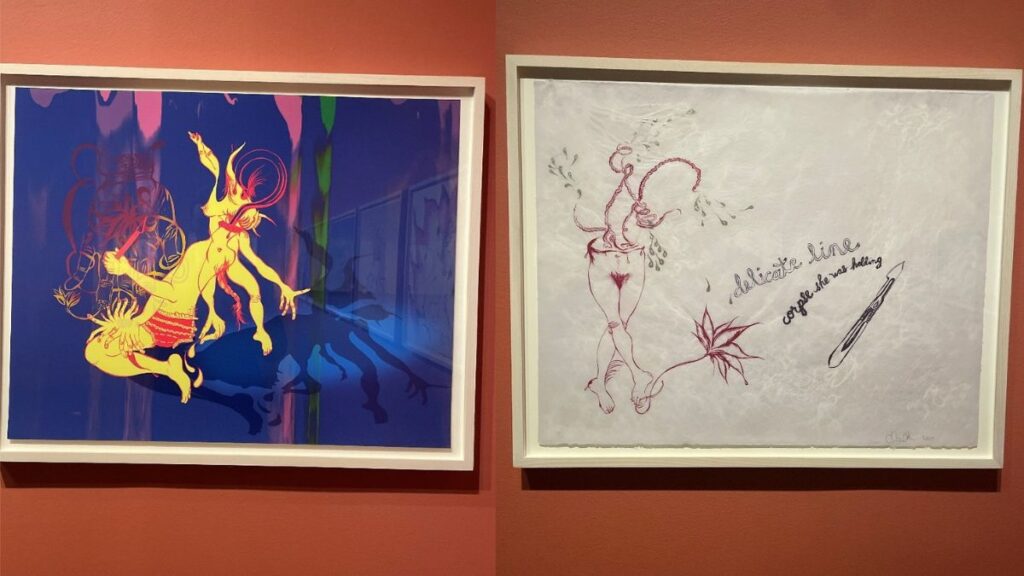
Image CreditCourtesy of Tourists and Visitors of the Smithsonian museums
“Chimerical figures are torn asunder; legs and hands spin and contort while entrails spill out of torsos, giving birth to new life forms,” the Smithsonian states of her art. “Signature motifs abound, including the multiple eyes, which symbolize heightened perception and sexuality, and the acrobat, whose body can respond in unexpected ways to inhabit marginal spaces.”

Image CreditCourtesy of Tourists and Visitors of the Smithsonian museums
Ganesh, who was born and raised in New York and went to Columbia University, injects Western academic gender theory into what is being sold as “Asian art.” Her art represents a moral inversion far from traditional Asian art, but visitors are led to believe this is a natural outgrowth of that cultural tradition even though it deliberately rejects beauty and order.
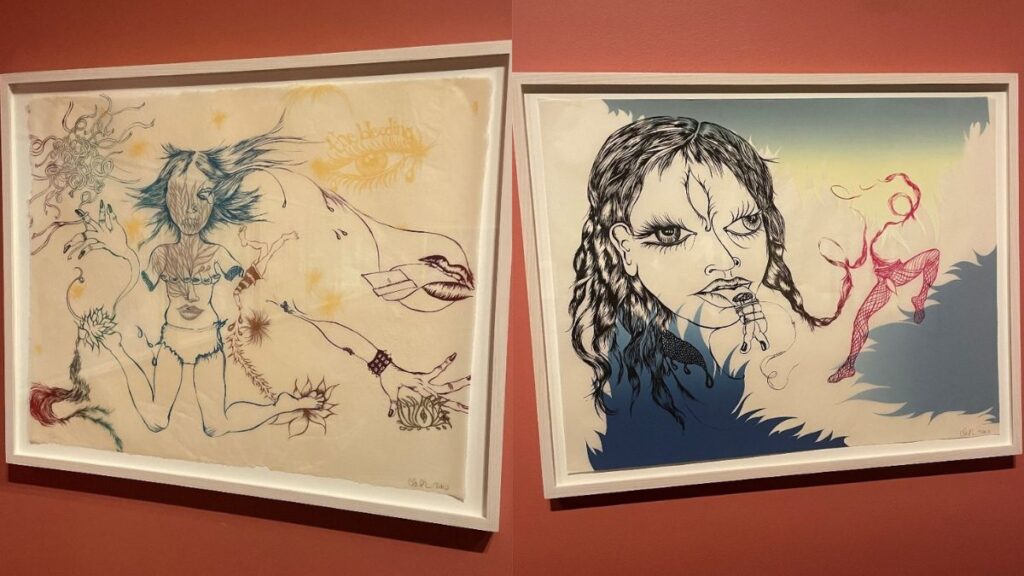
Image CreditCourtesy of Tourists and Visitors of the Smithsonian museums
The Asian Art Museum essentially took a museum based on a rich and ancient tradition and allowed visual arts majors to supplant it with feminist and gender studies messaging.
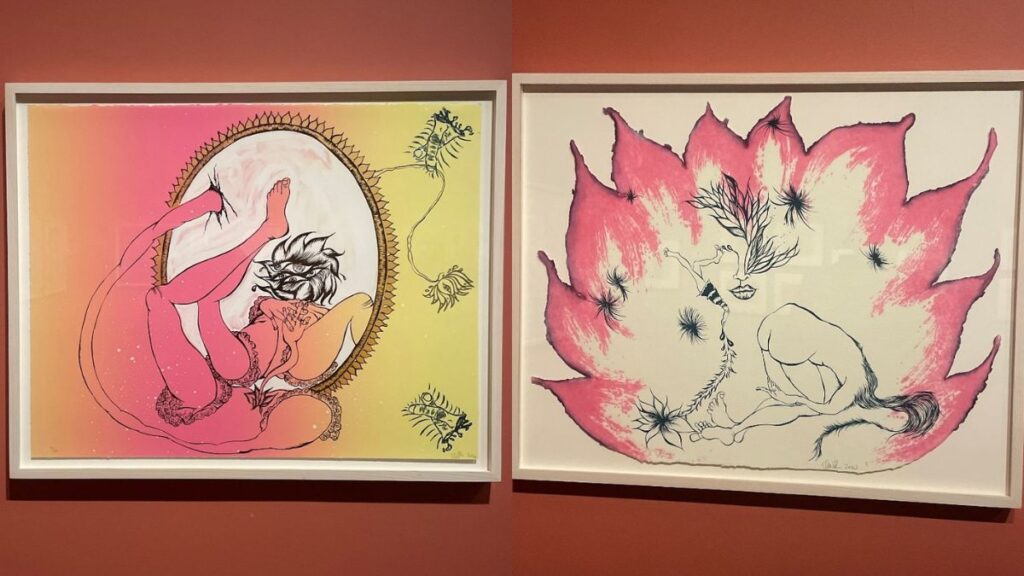
Image CreditCourtesy of Tourists and Visitors of the Smithsonian museums
Trump’s Review
The Trump administration’s review is not an attempt to make the Smithsonian museums “Trumpian” or to propagandize in a different direction. Rather, it is an attempt to right the ship of the Smithsonian Institution to weed out the academic provocateurs whose only goal is to put fake narratives and grotesque imagery in front of as many people as possible in order to distort their view of themselves, the country, and other cultures.
Breccan F. Thies is a correspondent for The Federalist. He previously covered education and culture issues for the Washington Examiner and Breitbart News. He holds a degree from the University of Virginia and is a 2022 Claremont Institute Publius Fellow. You can follow him on X: @BreccanFThies.








